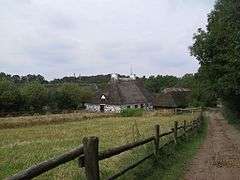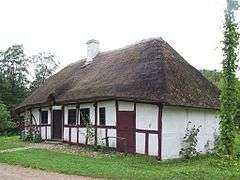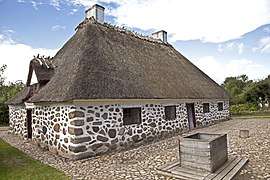The Funen Village
The Funen Village (Danish: Den Fynske Landsby) is an open-air museum located in the neighborhood of Fruens Bøge in Odense, Denmark. [1]

History
The Funen Village was founded as a public works project in 1942, during the German occupation of Denmark. The museum's open-air scene opened to the public already in 1944, and was used for patriotic song festivals (alsangsstævner) during the Occupation. It opened to the public on 1 April 1946. Among the guests attending the opening were King Christian X of Denmark.
It features 25 buildings from Funish villages, most of which date to the 18th and 19th century. The distribution of buildings includes a parsonage and watermill, an inn, a school, and a windmill as well as several residential structures. The vast majority are half-timbered buildings, as masonry buildings first became common in the countryside of Funen in the late 1800s. Tommerup parsonage farmhouse dates from 1692. The Bladstrup Brickwork dates from 1893.[2]
In addition to the buildings, the landscape contains examples ornamental gardens, with fruit trees of old Funen varieties. The village also features livestock, most often of Danish breeds: Danish Red cattle, Frederiksborg horses, Danish Landrace goats, Danish Landrace sheep, Danish Landrace pigs and Danish landrace geese. [3] [4] [5]
Gallery
 Scene from the Funen Village
Scene from the Funen Village Traditional timber framed house
Traditional timber framed house- Flour mill
 Village stone house
Village stone house Old horse wagon
Old horse wagon
See also
- Maderup Mølle
- Frilandsmuseet, Kongens Lyngby
- The Old Town in Aarhus
References
- "Funen Village". visitfyn.com. Retrieved September 1, 2019.
- "Den Fynske Landsby (Funen Village)". frommers.com. Retrieved September 1, 2019.
- "Frederiksborg Horse". Oklahoma State University Board of Regents. Retrieved September 1, 2019.
- "Danish Red Cattle". Oklahoma State University Board of Regents. Retrieved September 1, 2019.
- "Danish Landrace Swine". Oklahoma State University Board of Regents. Retrieved September 1, 2019.
Other sources
External links
| Wikimedia Commons has media related to Den Fynske Landsby. |
This article is a translation of the corresponding article on the Danish Wikipedia, accessed on 25 April 2007.